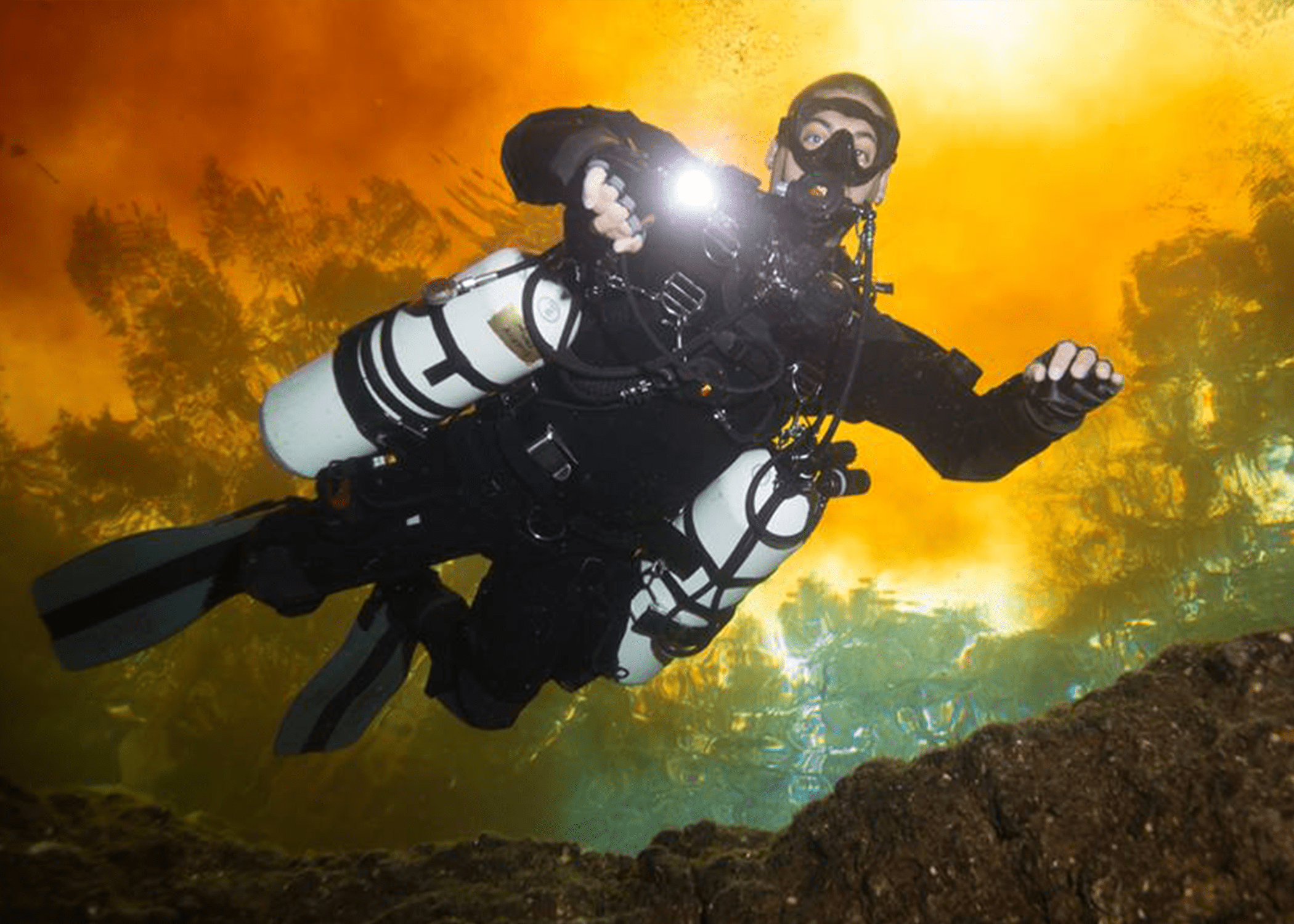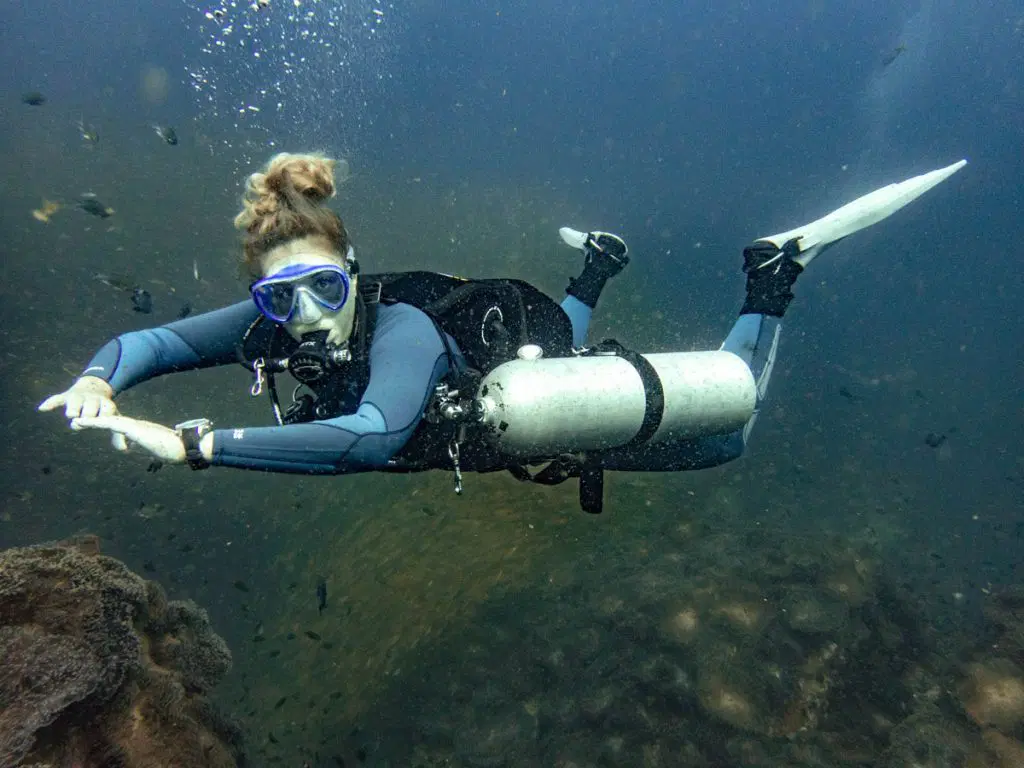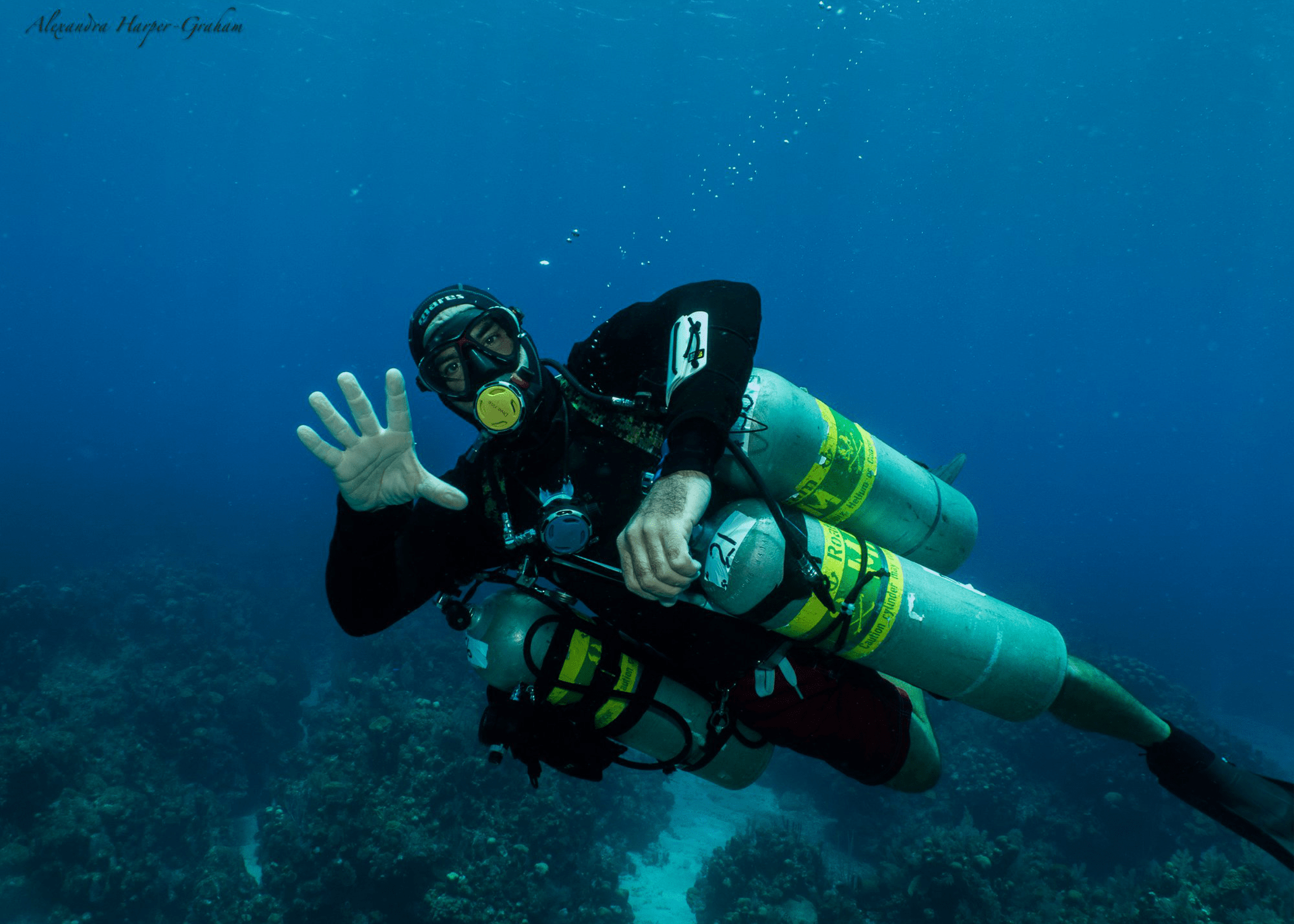A Strong Case For Sidemount
If you know me, you know I’ve long been a naysayer regarding the efficacy of sidemount diving. I’ve called it “widemount,” I’ve said it’s just for caves, I’ve called it a dumb fad that’ll soon pass, etc. Well, guess what? I was wrong, okay! I admit it! Ya happy now?? Alright, that’s out of the way…
On a cenote dive trip with my wife last year, I immediately noticed a few benefits of sidemount watching our guide, Camilo, gliding along ahead of us. One of the main things I saw was how easily he could look straight ahead while still staying in horizontal trim. To look straight ahead with a tank, or tanks, on your back, you have to dive at a slight angle so you don’t hit your head on the regulator’s first stage or the tank valve. This, obviously, puts the diver “out of trim” and means you have more drag and will, consequently, use more energy and breathing gas. Over the course of three days, watching our guide diving sidemount, I decided to bite the bullet and learn it myself.
So, on our group trip to Roatan earlier this year, I flew down a couple days early and took the sidemount course from my buddy, Monty Graham. When I learn something, I prefer to learn from the best if possible, and he is. I was fully prepared to look and feel like a complete monkey trying out a brand-new configuration with which I was totally unfamiliar, but I was amazed at how naturally I took to it. All the skills came quite easily, and after getting certified, I went ahead and dove that way all week. Now, I can honestly say I don’t care if I ever put a tank, or tanks, on my back again. Let’s look at some of the points that make sidemount diving so awesome:
- Double the gas – If you happen to be “that diver” who’s always the first one back on the boat, switching to sidemount will give you plenty of gas to stay down with the “sippers.” If you’re not an air hog, you’ve really got it made. Just use the same two cylinders for both of your 2-tank morning dives. No switching kit from one cylinder to the next during your surface interval. AND think about nitrox for a sec… The ol’ voodoo gas gives you so much more allowable bottom time, you usually run up against a gas supply limit before you run out of NDLs. In sidemount now you have a gas supply to match your nitrox-induced extra bottom time!
- A giant stride is a giant breeze – You can splash with no cylinders, let the boat crew hand your cylinders down to you, and clip them on in the water, OR you can clip on the left cylinder, splash while holding the right cylinder, and clip just the right one on in the water. The latter is my preferred method.
- Boarding the boat is even easier – During your safety stop you can stow your long hose, completely unclip the right cylinder, and detach everything on the left cylinder except one clip. When you surface at the back of the boat, hand your right cylinder to the boat crew, unclip the left, hand it up, slip your fins over your wrists, and climb up totally unencumbered! You’ll learn how to do this during the course.
- Trimmed out – If you’ve struggled to get that perfect, horizontal position in the water, you’ll love your trim in sidemount. Once you get the BC adjusted and cylinder attachment points set, it’s actually difficult to get OUT of trim!
- So well balanced – Because you switch regulators every 300 psi, diving sidemount keeps you perfectly balanced. Remember what it feels like to roll over on your back to look up at the surface or your dive buddy above you? Once you’re about halfway over, the weight of the tank wants to pull you the rest of the way, and then to roll right side up, you have put a little extra oomph into getting that tank started until you’re about halfway rolled over again. With the balance of sidemount, you can easily roll over and stop in any position without getting pulled over. Makes going through narrow cracks a breeze. Just roll sideways and go!
- Make restrictions your (female dog) – If you enjoy diving the “swiss cheese” swim-throughs common to Roatan, the Caymans, and many other places, sidemount lends itself perfectly to that environment. Simply unclip the bottom of one cylinder (they’re still held in place by the bungee around the valve), swing it in front of you to narrow up your profile, and swim on. If the restriction is even smaller, just unclip both cylinders and hold them in front of you. Swim through the restriction, swing them back, and clip them on. Easy peasy. PRO TIP: If it’s dark in the swim-throughs (night diving, cloudy day, whatever), you can tuck your flashlight under the bottom hose management band on your right cylinder, leave your left hand free, and wherever you point your tank, there’s your light. Beats paying huge money for a canister light!
- Redundancy – As a sport (recreational) diver, you were taught to go to your buddy in the event of a problem like out-of-gas or a regulator failure. Diving sidemount means you have two completely independent systems attached to you. Regulator failure? Switch to your other one. Accidentally run out of breathing gas? Switch to your other one. Of course, that one better not happen!
- Ease of fixing issues – In a backmount configuration it’s difficult, if not impossible, to even tell if there’s a problem, much less fix it. Many technical divers have switched to sidemount because they simply couldn’t even reach the valves on a backmounted set of doubles to do valve drills. In sidemount the regs, valves, and anything else you need are right in front of you. You can see any problems and fix them in a snap. Did I mention “easy peasy” already?
Okay, let’s play devil’s advocate just to be fair. As awesome as it is, sidemount does have a few drawbacks:
- You’ll need more gear – Sidemount does require two separate regulators, one for each cylinder, but at least you don’t need octos. Cylinder valves really need to be modular for bungee security, and they really need to be DIN. Yoke connections are okay for open-water sport diving, but if you’re going to do anything in the tech world or even recreational overhead diving, you ought to think about switching to DIN. It’s a much better connection anyway. And you’re going to need a new BC. You don’t want to clip sidemount cylinders to a standard BC. It has been done, but your trim, balance, comfort, everything will be negatively affected. If you’re going to do something, do it right. Besides, except for the money part, who doesn’t want more scuba gear??
- Shore diving can be a little cumbersome – You now have to lug two cylinders to the water’s edge instead of simply wearing one. But you can always clip your fins to your BC and do it in just one trip. If you’re a shorter diver, and carrying cylinders by the valve means they’ll be bumping the ground, do what my friend, Kim, does. Wrap one of those Velcro tank carry handles around each one, and carry them sideways. You can even leave the handles on during the dive.
- Slightly more involved gas management – If you’ve been diving for a while and are pretty used to your gas consumption, you probably don’t check your SPG or air-integrated computer that often anymore. During an hour-ish fun dive in the islands, I usually check mine at the 30-minute mark (just to confirm what I already know) and again at the 45- or 50-minute mark just to double check I’ve got plenty for a safety stop and reserve. In sidemount it is incumbent that you switch regs every 300 psi to keep yourself in balance, so you’ll need to check your SPGs a little more often. Once you get used to doing that, however, it’s no biggie at all.
So, the jury is in: sidemount diving is the bomb! Originally developed by serious cave explorers out of necessity for navigating tight restrictions, sidemount diving has enjoyed a huge surge in popularity over the years to the point that it’s now quite mainstream in both technical and sport diving. The few drawbacks, at least in the author’s opinion, are greatly outweighed by the freedom, balance, trim, extra gas, ease of problem-solving, and more that sidemount provides. I highly encourage you to come take the PADI Sidemount Diver course with me, and I’ll show you why I think it’s so awesome. I think you’ll agree. I provide all the gear for the class, so don’t worry that you’ll have to spend a bunch of money before you decide whether sidemount is for you or not. Drop me a line or come by the shop any time to ask questions and/or get signed up. Remember: once you go sidemount, you’ll never go back…mount!
Until next time, keep learning, never settle for “good enough,” and stay sharky, my friends!
Why Should You Consider Going Sidemount?

Extra Gas!
Tired of being the first one back on the boat? Doubling your gas supply could be the answer. It’s also beneficial when diving nitrox so you’ll have a gas supply to match your extended NDLs.

Trim, Trim, Trim!
Want to look like this in the water? You should! It’s easier, more confortable, and much more hydrodynamic. You’ll use less energy and less breathing gas. Yes, acheiving perfect trim boils down to YOU: proper amount and position of weighting, body position, breathing, gear configuration, fin type, and even mental concentration are the basics of good trim. It’s just a LOT easier to acheive in sidemount!

What Restrictions?!
Opening to a swim through or a wreck a little tight? No problem! Just unclip one, or both, of your cylinders, swing it out front, enjoy the swim through or wreck, then swing it back and clip it back on when you’re through. You can even stick your flashlight in the bottom band for darker places. Photo credit: Audrey Cudel

Easier Fixes!
In sidemount the valves and regulator first stages are right in front of your armpits, so everything is easy to see, diagnose, and fix, if necessary. Ever jumped in but forgot to turn your tank valve on? You either had to get back out of the water or swim over to somebody, turn around, and ask them to do it for you. With the valves right in front of you in sidemount, you can do it yourself in about 2 seconds!

Well Suited For Tech!
If you’ve considered technical diving but aren’t excited about heavy doubles on your back, or you’re worried you can’t reach the valves, do tech in sidemount! Attach as many or as few cylinders as the dive calls for, and have all of them in easy reach. Photo credit: Alex Harper-Graham

It Comes Naturally!
Yes, everything new has a bit of a learning curve, but sidemount just FEELS right earlier on. Here’s the author being silly in Roatan with fewer than 20 sidemount dives at the time, but still totally comfortable in the new configuration.


